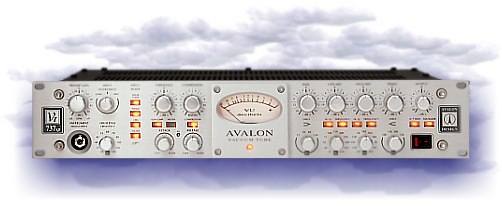
|
REVIEWS: From STUDIO SOUND UK, April, 1998 |
|
A next move from the 'purist' camp to 'classic sees Avalon launch a valve channel strip. Dave Foister reports
 This is not altogether a new model, but the original version has been joined by the SP variant, replacing garish purple knobs with the custom type fitted to the existing range. These are long, fluted aluminum controls, big enough to end up almost too close together and protruding far enough to risk obscuring the panel graphics. The graphics, like the knobs, are more subtle than on the original, making do with simple charcoal legends in place of purple panels. The transformation is startling, turning an eye-poking statement into a model of functional elegance. And functionality is something the 737 has in abundance. However esoteric the circuit topology, there's nothing minimalist about the facilities. The input stage has three inputs, for balanced microphones and lines and unbalanced instruments, and a continuously-variable gain pot is followed by a switchable swept high-pass filter. This leads into the compressor, which in common with the solid-state AD2044 uses an optical gain control element, eliminating VCAs and ICs. Two of the valves sit either side of this, and the ensemble gives a simple effective compressor. Continuously variable Threshold, Ratio, Attack and Release controls allow virtually any type of compression characteristic to be set up, and the dominant central vu meter can be switched to show resulting gain reduction. The compressor section, like all the other blocks, can be bypassed when not in use. In normal use the equaliser follows the compressor. No valves are used in this stage, which is based on the same class-A ideas as found in the 2055 EQ. HF and LF shelving controls each have four switched turnover frequencies, and the two mid bands are fully swept with x10 ranging switches. Bandwidth is only variable to the extent that each mid has a HIGH Q button to narrow it down, but in practice the two options meet most needs. All the bands have a more than generous frequency range, the HF in particular throwing down the gaunt- let by having a setting above 20kHz, at 32kHz. Of course, this frequency represents the 3dB down point or something (it's not specified) so its effect can be heard in the conventional audio band as a subtle smoothing or an extra sheen. One of the things that marks down the 737 as out of the ordinary is a number of thoughtful details that make the unit even more flexible than it at first appears. For starters, the order of the blocks can be swapped around with a single switch, so that the EQ comes before the compressor. Personally this is how I prefer to work in most instances, feeling that the compressor should be given as finished a version of the signal you want before doing its job, so the ability to lay it out like this where others force you the other way is much appreciated. But an even more useful touch is the ability to switch the mid-band swept equalisers into the compressor's side chain for frequency- related effects like de-essing, leaving the bass and treble bands for signal sweetening. Besides the expected ins and outs on XLRs, the rear panel has a 2-pole jack for linking the compressors on two 737s for stereo use - quite a powerful combination. The equalisers, of course remain completely separate. There is also a link on a barrier strip for separating audio and chassis grounds. It's hard to fault the VT-737. Not only does it give you the kind of
audiophile signal handling that has made Avalon's name, but it does
it with a breadth of facilities rarely found on a device with such high
sonic aspirations. The sound quality is indeed superb, with real transparency
and very low noise. Avalon likens the behaviour of its equalisers to
that of a passive design, and that seems to be true in that cranking
it up, even with the high gain ranges available, doesn't seem to contribute
any additional noise or other by-products. The compressor too, with
its unconventional approach (shared with Joe Meek but not many others),
seems to do nothing to the signal except compress it - not as obvious
a point to make as it might seem. Some of these all in-one signal paths
trade heavily on one strength, but the VT-737 is equally convincing
in all its roles, with every block desirable in its own right. Add the
flexibility that comes with integration and it's a winner. Back to Reviews Index & User List |
Tel: +1 949 492
2000
©2023 Avalon Design USA LLC